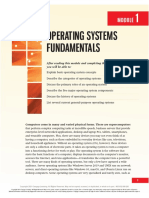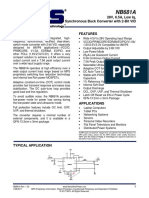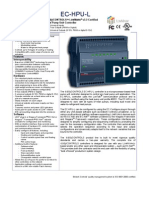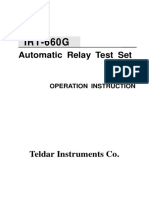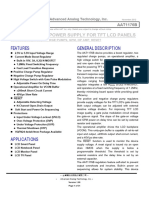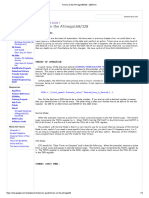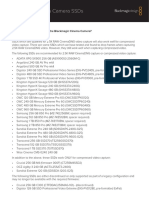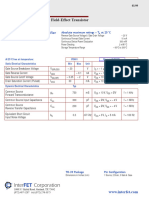APW7142
APW7142
Uploaded by
gsmaster4141Copyright:
Available Formats
APW7142
APW7142
Uploaded by
gsmaster4141Original Title
Copyright
Available Formats
Share this document
Did you find this document useful?
Is this content inappropriate?
Copyright:
Available Formats
APW7142
APW7142
Uploaded by
gsmaster4141Copyright:
Available Formats
APW7142
3A, 12V, Synchronous-Rectified Buck Converter
Features General Description
• Wide Input Voltage from 4.3V to 14V The APW7142 is a 3A synchronous-rectified Buck con-
• Output Current up to 3A verter with integrated 70mΩ power MOSFETs. The
OM
• Adjustable Output Voltage from 0.8V to VIN APW7142, designed with a current-mode control scheme,
- ±2% System Accuracy can convert wide input voltage of 4.3V to 14V to the output
voltage adjustable from 0.8V to VIN to provide excellent
• 70mΩ Integrated Power MOSFETs
output voltage regulation.
• High Efficiency up to 95%
For high efficiency over all load current range, the
.C
- Automatic Skip/PWM Mode Operation
APW7142 is equipped with an automatic Skip/PWM mode
• Current-Mode Operation
operation. At light load, the IC operates in the Skip mode,
- Easy Feedback Compensation
which keeps a constant minimum inductor peak current,
- Stable with Low ESR Output Capacitors to reduce switching losses. At heavy load, the IC works in
- Fast Load/Line Transient Response PWM mode, which inductor peak current is programmed
•
•
•
•
Power-On-Reset Monitoring
Fixed 500kHz Switching Frequency in PWM Mode
Built-In Digital Soft-Start and Soft-Stop
IC
Current-Limit Protection with Frequency Foldback
by the COMP voltage, to provide high efficiency and excel-
lent output voltage regulation.
The APW7142 is also equipped with power-on-reset,
soft-start, soft-stop, and whole protections (under-voltage,
over-voltage, over-temperature, and current-limit) into a
•
T-
123% Over-Voltage Protection
single package. In shutdown mode, the supply current
• Hiccup-Mode 50% Under-Voltage Protection
drops below 3µA.
• Over-Temperature Protection
This device, available in a 8-pin SOP-8 package, pro-
• <3µA Quiescent Current in Shutdown Mode
vides a very compact system solution with minimal exter-
• Small SOP-8 Package
SE
nal components and PCB area.
• Lead Free and Green Devices Available
(RoHS Compliant) 100
90
Applications 80
IP
70
Efficiency (%)
60 VIN=5V, VOUT=3.3V, L1=2.2µF
• OLPC, UMPC
50
• Notebook Computer
40
• Handheld Portable Device VIN=12V, VOUT=5V, L1=6.8µF
30
CH
• Step-Down Converters Requiring High Efficiency 20
VIN=12V, VOUT=3.3V, L1=4.7µF
and 3A Output Current
10
0
0.001 0.01 0.1 1 10
Output Current, IOUT(A)
ANPEC reserves the right to make changes to improve reliability or manufacturability without notice, and
advise customers to obtain the latest version of relevant information to verify before placing orders.
Copyright ANPEC Electronics Corp. 1 www.anpec.com.tw
Rev. A.6 - Nov., 2010
APW7142
Ordering and Marking Information
APW7142 Package Code
K : SOP-8
Assembly Material Operating Junction Temperature Range
Handling Code I : -40 to 85 oC
Handling Code
Temperature Range TR : Tape & Reel
Package Code Assembly Material
OM
G : Halogen and Lead Free Device
APW7142
APW7142 K : XXXXX XXXXX - Date Code
Note: ANPEC lead-free products contain molding compounds/die attach materials and 100% matte tin plate termination finish; which
are fully compliant with RoHS. ANPEC lead-free products meet or exceed the lead-free requirements of IPC/JEDEC J-STD-020D for
.C
MSL classification at lead-free peak reflow temperature. ANPEC defines “Green” to mean lead-free (RoHS compliant) and halogen
free (Br or Cl does not exceed 900ppm by weight in homogeneous material and total of Br and Cl does not exceed 1500ppm by
weight).
Pin Configuration
PGND
VIN
AGND
FB
1
2
3
4
APW7142
8
7
6
5
LX
LX
EN
COMP
IC
T-
SOP-8
Top View
Absolute Maximum Ratings (Note 1)
Symbol Parameter Rating Unit
SE
VIN VIN Supply Voltage (VIN to AGND) -0.3 ~ 15 V
> 100ns -1 ~ VIN+1
VLX LX to GND Voltage V
< 100ns - 5 ~ VIN+5
PGND to AGND Voltage -0.3 ~ +0.3 V
IP
EN to AGND Voltage -0.3 ~ VIN+0.3 V
FB, COMP to AGND Voltage -0.3 ~ 6 V
PD Power Dissipation Internally Limited W
o
Maximum Junction Temperature 150 C
o
TSTG Storage Temperature -65 ~ 150 C
CH
o
TSDR Maximum Lead Soldering Temperature, 10 Seconds 260 C
Note 1: Absolute Maximum Ratings are those values beyond which the life of a device may be impaired. Exposure to absolute
maximum rating conditions for extended periods may affect device reliability.
Thermal Characteristics
Symbol Parameter Typical Value Unit
Junction-to-Ambient Thermal Resistance in Free Air (Note 2)
θJA
o
80 C/W
SOP-8
Note 2: θJA is measured with the component mounted on a high effective thermal conductivity test board in free air.
Copyright ANPEC Electronics Corp. 2 www.anpec.com.tw
Rev. A.6 - Nov., 2010
APW7142
Recommended Operating Conditions (Note 3)
Symbol Parameter Range Unit
VIN VIN Supply Voltage 4.3 ~ 14 V
VOUT Converter Output Voltage 0.8 ~ VIN V
IOUT Converter Output Current 0~3 A
CIN Converter Input Capacitor (MLCC) 8 ~ 50 µF
OM
Converter Output Capacitor 20 ~ 1000 µF
COUT
Effective Series Resistance 0 ~ 60 mΩ
LOUT Converter Output Inductor 1 ~ 22 µH
Resistance of the Feedback Resistor connected from FB to GND 1 ~ 20 kΩ
.C
o
TA Ambient Temperature -40 ~ 85 C
o
TJ Junction Temperature -40 ~ 125 C
Note 3: Refer to the Typical Application Circuits
Electrical Characteristics
specified. Typical values are at TA=25°C.
Symbol Parameter
IC
Refer to the typical application circuits. These specifications apply over VIN=12V, VOUT=3.3V and TA= -40 ~ 85°C, unless otherwise
Test Conditions
APW7142
Unit
T-
Min. Typ. Max.
SUPPLY CURRENT
IVIN VIN Supply Current VFB = VREF +50mV, VEN=3V, LX=NC - 0.5 1.5 mA
IVIN_SD VIN Shutdown Supply Current VEN = 0V - - 3 µA
POWER-ON-RESET (POR) VOLTAGE THRESHOLD
SE
VIN POR Voltage Threshold VIN rising 3.9 4.1 4.3 V
VIN POR Hysteresis - 0.5 - V
REFERENCE VOLTAGE
VREF Reference Voltage Regulated on FB pin - 0.8 - V
TJ = 25oC, IOUT=10mA, VIN=12V -1.0 - +1.0
IP
Output Voltage Accuracy %
IOUT=10mA~3A, VIN=4.75~14V -2.0 - +2.0
Line Regulation VIN = 4.75V to 14V - +0.02 - %/V
Load Regulation IOUT = 0.5A ~ 3A - -0.04 - %/A
OSCILLATOR AND DUTY CYCLE
CH
FOSC Oscillator Frequency TJ = -40 ~ 125oC, VIN = 4.75 ~ 14V 450 500 550 kHz
Foldback Frequency VOUT = 0V - 80 - kHz
Maximum Converter’s Duty - 99 - %
TON_MIN Minimum Pulse Width of LX - 150 - ns
CURRENT-MODE PWM CONVERTER
Gm Error Amplifier Transconductance VFB=VREF±50mV - 200 - µA/V
Error Amplifier DC Gain COMP = NC - 80 - dB
Copyright ANPEC Electronics Corp. 3 www.anpec.com.tw
Rev. A.6 - Nov., 2010
APW7142
Electrical Characteristics (Cont.)
Refer to the typical application circuits. These specifications apply over VIN=12V, VOUT=3.3V and TA= -40 ~ 85°C,
unless otherwise specified. Typical values are at TA=25°C.
APW7142
Symbol Parameter Test Conditions Unit
Min. Typ. Max.
CURRENT-MODE PWM CONVERTER (CONT.)
OM
Current-Sense to COMP Voltage
- 0.048 - V/A
Transresistance
VIN = 5V, TJ=25°C - 90 110
High-side Switch Resistance mΩ
VIN = 12V, TJ=25°C - 70 90
VIN = 5V, TJ=25°C - 90 110
.C
Low-side Switch Resistance mΩ
VIN = 12V, TJ=25°C - 70 90
PROTECTIONS
ILIM High-Side Switch Current-Limit Peak Current 4.0 5.5 7.0 A
VTH_UV FB Under-Voltage Threshold VFB falling 45 50 55 %
VTH_OV FB Over-Voltage Threshold VFB rising 118 123 128 %
TOTP
TD
FB Under-Voltage Debounce
Over-Temperature Trip Point
Over-Temperature Hysteresis
Dead-Time
IC
VLX = -0.7V
-
-
-
-
1
150
40
20
-
-
-
-
µs
o
ns
C
C
T-
SOFT-START, SOFT-STOP, ENABLE AND INPUT CURRENTS
TSS Soft-Start / Soft-Stop Interval 1.5 2 2.5 ms
EN Logic Low Voltage VEN falling - - 0.5 V
EN Logic High Voltage VEN rising 2.1 - - V
High-Side Switch Leakage Current VEN = 0V, VLX = 0V - - 2 µA
SE
IFB FB Pin Input Current -100 - +100 nA
IEN EN Pin Input Current VEN = 0V ~ VIN -100 - +100 nA
IP
CH
Copyright ANPEC Electronics Corp. 4 www.anpec.com.tw
Rev. A.6 - Nov., 2010
APW7142
Typical Operating Characteristics
(Refer to the application circuit 1 in the section “Typical Application Circuits”, VIN=12V, VOUT=3.3V, L1=4.7µH)
Output Current vs. Efficiency Output Voltage vs. Output Current
100 3.4
90 3.38
Output Voltage, VOUT (V)
80 3.36
OM
Efficiency (%)
70 3.34
60 3.32
VIN=5V, VOUT=3.3V, L1=2.2µF
50 3.3
40 3.28
VIN=12V, VOUT=5V, L1=6.8µF
3.26
.C
30
20 3.24
VIN=12V, VOUT=3.3V, L1=4.7µF
10 3.22
0 3.2
0.001 0.01 0.1 1 10 0 1 2 3
Output Current, IOUT(A) Output Current, IOUT(A)
7
Current Limit Level (Peak Current)
vs. Junction Temperature IC 3.4
3.38
Output Voltage vs. Supply Voltage
IOUT=500mA
Current Limit Level, ILIM(A)
Output Voltage, VOUT (V)
6.5 3.36
T-
3.34
6 3.32
3.3
5.5 3.28
SE
3.26
5 3.24
3.22
4.5 3.2
-40 -20 0 20 40 60 80 100 120 140 4 6 8 10 12 14
IP
o
Junction Temperature, TJ ( C) Supply Voltage, VIN (V)
VIN Input Current vs. Supply Voltage Reference Voltage vs. Junction Temperature
2.0 0.816
VFB=0.85V
0.812
Reference Voltage, VREF (V)
CH
VIN Input Current, I VIN(mA)
1.5 0.808
0.804
1.0 0.800
0.796
0.5 0.792
0.788
0.0 0.784
0 2 4 6 8 10 12 14 -50 -25 0 25 50 75 100 125 150
Supply Voltage, VIN (V) Junction Temperature, TJ (oC)
Copyright ANPEC Electronics Corp. 5 www.anpec.com.tw
Rev. A.6 - Nov., 2010
APW7142
Typical Operating Characteristics (Cont.)
(Refer to the application circuit 1 in the section “Typical Application Circuits”, VIN=12V, VOUT=3.3V, L1=4.7µH)
Oscillator Frequency vs.
Junction Temperature
550
540
Oscillator Frequency, FOSC(kHz)
OM
530
520
510
500
490
.C
480
470
460
450
-50 -25 0 25 50 75 100 125 150
o
Junction Temperature, TJ ( C)
IC
T-
SE
IP
CH
Copyright ANPEC Electronics Corp. 6 www.anpec.com.tw
Rev. A.6 - Nov., 2010
APW7142
Operating Waveforms
(Refer to the application circuit 1 in the section “Typical Application Circuits”, VIN=12V, VOUT=3.3V, L1=4.7µH)
Power On Power Off
OM
IOUT=3A IOUT=3A
VIN
VIN
1 1
.C
VOUT
VOUT
2 2
IL1 IL1
3
CH1 : VIN , 5V/div
CH2 : VOUT , 2V/div
CH3 : IL1 , 2A/div
IC 3
CH1 : VIN , 5V/div
CH2 : VOUT , 2V/div
CH3 : IL1 , 2A/div
T-
Time : 1ms/div Time : 10ms/div
SE
Enable Shutdown
IOUT=3A
IOUT=3A
IP
VEN VEN
1 1
VOUT VOUT
2 2
CH
IL1 IL1
3 3
CH1 : VEN , 5V/div CH1 : VEN , 5V/div
CH2 : VOUT , 2V/div CH2 : VOUT , 2V/div
CH3 : IL1 , 2A/div CH3 : IL1, 2A/div
Time : 1ms/div Time : 100µs/div
Copyright ANPEC Electronics Corp. 7 www.anpec.com.tw
Rev. A.6 - Nov., 2010
APW7142
Operating Waveforms (Cont.)
(Refer to the application circuit 1 in the section “Typical Application Circuits”, VIN=12V, VOUT=3.3V, L1=4.7µH)
Short Circuit Short Circuit
OM
IOUT =3~7A VOUT is shorted to GND by a short wire
VLx
1 VLX
.C
VOUT
VOUT
2 2
IL1 IL1
3
CH1 : VLX , 10V/div
CH2 : VOUT , 2V/div
CH3 : IL1 , 5A/div
IC 3
CH1 : VLX , 5V/div
CH2 : VOUT , 200mV/div
CH3 : IL1 , 5A/div
T-
Time : 20µs/div Time : 5ms/div
SE
Load Transient Response Load Transient Response
IOUT= 50mA-> 3A ->50mA IOUT= 0.5A-> 3A ->0.5A
IOUT rising/falling time=10µs IOUT rising/falling time=10µs
VOUT VOUT
1
IP
IL1 IL1
CH
2 2
CH1 : VOUT , 200mV/div CH1 : VOUT , 100mV/div
CH2 : IL1 , 2A/div CH2 : IL1 , 2A/div
Time : 100µs/div Time : 100µs/div
Copyright ANPEC Electronics Corp. 8 www.anpec.com.tw
Rev. A.6 - Nov., 2010
APW7142
Operating Waveforms (Cont.)
(Refer to the application circuit 1 in the section “Typical Application Circuits”, VIN=12V, VOUT=3.3V, L1=4.7µH)
Switching Waveform Switching Waveform
OM
IOUT=0.2A VLX VLX
IOUT=3A
.C
1 1
IL1
IL1
2 2
CH1 : VLX , 5V/div
CH2 : IL1 , 2A/div
Time : 1µs/div
IC CH1 : VLX , 5V/div
CH2 : IL1 , 2A/div
Time : 1µs/div
T-
Line Transient Over-Voltage Protection
SE
VIN= 5~12V VIN rising/falling time=20µs VIN
VIN
VOUT
IP
1 1
VOUT VLX
2 2
IL1 3
IL1
CH
3
IOUT=-1A
CH1 : VIN , 5V/div CH1 : VIN , 5V/div
CH2 : VOUT , 50mV/div (Voffset=3.3V) CH2 : VOUT , 2V/div
CH3 : IL1 , 2A/div CH3 : VLX , 5V/div
Time : 100µs/div CH4 : IL1 , 5A/div
Time : 20µs/div
Copyright ANPEC Electronics Corp. 9 www.anpec.com.tw
Rev. A.6 - Nov., 2010
APW7142
Pin Description
PIN
FUNCTION
NO. NAME
Power Ground of the APW7142, which is the source of the N-channel power MOSFET.
1 PGND
Connect this pin to system ground with lowest impedance.
Power Input. VIN supplies the power (4.3V to 14V) to the control circuitry, gate drivers
and step-down converter switches. Connecting a ceramic bypass capacitor and a
OM
2 VIN
suitably large capacitor between VIN and both of AGND and PGND eliminates switching
noise and voltage ripple on the input to the IC.
3 AGND Ground of MOSFET Gate Drivers and Control Circuitry.
Output feedback Input. The APW7142 senses the feedback voltage via FB and
4 FB regulates the voltage at 0.8V. Connecting FB with a resistor-divider from the converter’s
output sets the output voltage from 0.8V to VIN.
.C
Output of the error amplifier. Connect a series RC network from the COMP to the GND to
5 COMP compensate the regulation control loop. In some cases, an additional capacitor from the
COMP to the GND is required.
Enable Input. EN is a digital input that turns the regulator on or off. Drive EN high to turn
6 EN
on the regulator, drive it low to turn it off. Connect this pin to the VIN if it is not used.
Power Switching Output. LX is the junction of the high-side and low-side power
7, 8
Block Diagram
LX
IC
MOSFETs to supply power to the output LC filter.
VIN
T-
Current Sense
Amplifier VIN
Power-On- Current
Reset Limit
SE
Zero-Crossing
POR Comparator
UG
OVP
123%VREF Soft-Start /
Soft-Stop Gate
and Driver
50%VREF UVP Fault Logic
IP
Soft-Start /
Soft-Stop Inhibit
Gate LX
FB Control VIN
Gm
VREF Error LG
Amplifier Current Gate
Compartor Driver
CH
COMP PGND
Slope
Compensation
Oscillator AGND
EN Enable Over
500kHz
1.5V Temperature FB
Protection
Copyright ANPEC Electronics Corp. 10 www.anpec.com.tw
Rev. A.6 - Nov., 2010
APW7142
Typical Application Circuits
1. 4.3~14V Single Power Input Step-Down Converter (with a Ceramic Output Capacitor)
VIN
2 C1
VIN
OM
L1
Enable
6 8 VOUT
EN LX
Shutdown U1 LX 7
APW7142
PGND 1 C2
5 COMP R1
±
1%
.C
R3 4
FB
±5%
C3 AGND R2
±
30% 3 ±1% C4
±30%, Optional
VIN(V)
12
12
12
VOUT(V)
3.3
5
5
L1(µH)
6.8
6.8
4.7
C2(µF)
22
44
22
IC
a. Cost-effective Feedback Compensation (C4 is not connected)
C2 ESR(mΩ)
5
3
5
R1(kΩ)
63.0
63.0
46.9
R2(kΩ)
12
12
15
R3(kΩ)
10.0
20.0
10.0
C3(pF)
1500
1500
1500
T-
12 3.3 4.7 44 3 46.9 15 22.0 1500
12 2 3.3 22 5 30.0 20 10.0 1500
12 2 3.3 44 3 30.0 20 20.0 1500
12 1.2 2.2 22 5 7.5 15 8.2 1800
SE
12 1.2 2.2 44 3 7.5 15 16.0 1800
5 3.3 2.2 22 5 46.9 15 8.2 680
5 3.3 2.2 44 3 46.9 15 20.0 680
5 1.2 2.2 22 5 7.5 15 3.0 1800
5 1.2 2.2 44 3 7.5 15 7.5 1800
IP
b. Fast-Transient-Response Feedback Compensation (C4 is connected)
VIN(V) VOUT(V) L1(µH) C2(µF) C2 ESR(mΩ) R1(kΩ) R2(kΩ) C4(pF) R3(kΩ) C3(pF)
12 5 6.8 22 5 63.0 12 47 33.0 470
12 5 6.8 44 3 63.0 12 47 68.0 470
CH
12 3.3 4.7 22 5 46.9 15 47 22.0 680
12 3.3 4.7 44 3 46.9 15 47 47.0 680
12 2 3.3 22 5 30.0 20 47 13.0 1200
12 2 3.3 44 3 30.0 20 47 27.0 1200
12 1.2 2.2 22 5 7.5 15 150 7.5 2200
12 1.2 2.2 44 3 7.5 15 150 15.0 2200
5 3.3 2.2 22 5 46.9 15 56 20.0 220
5 3.3 2.2 44 3 46.9 15 56 43.0 220
5 1.2 2.2 22 5 7.5 15 330 3.3 1800
5 1.2 2.2 44 3 7.5 15 330 8.2 1500
Copyright ANPEC Electronics Corp. 11 www.anpec.com.tw
Rev. A.6 - Nov., 2010
APW7142
Typical Application Circuits (Cont.)
2. +12V Single Power Input Step-Down Converter (with an Electrolytic Output Capacitor)
VIN
C1 C5 12V
OM
2
2.2µF 470µF
VIN
L1
Enable 4.7µH /3A VOUT
6 8 3.3V/3A
EN LX
Shutdown U1 LX 7
APW7142 C2
.C
PGND 1 470µF
R1
5 COMP (ESR=30mΩ)
46.9K
R3 ±1%
FB 4
62K
±5%
R2
AGND
C3 15K
3
680pF
±30%
IC ±1% C4
47pF
±30%
T-
SE
IP
CH
Copyright ANPEC Electronics Corp. 12 www.anpec.com.tw
Rev. A.6 - Nov., 2010
APW7142
Function Description
VIN Power-On-Reset (POR)
The APW7142 keeps monitoring the voltage on VIN pin to The under-voltage threshold is 50% of the nominal out-
prevent wrong logic operations which may occur when put voltage. The under-voltage comparator has a built-in
VIN voltage is not high enough for the internal control 2µs noise filter to prevent the chips from wrong UVP shut-
OM
circuitry to operate. The VIN POR has a rising threshold of down being caused by noise. The under-voltage protec-
4.1V (typical) with 0.5V of hysteresis. tion works in a hiccup mode without latched shutdown.
During startup, the VIN voltage must exceed the enable The IC will initiate a new soft-start process at the end of
voltage threshold. Then, the IC starts a start-up process the preceding delay.
and ramps up the output voltage to the voltage target.
Over-Voltage Protection (OVP)
.C
Digital Soft-Start The over-voltage function monitors the output voltage by
The APW7142 has a built-in digital soft-start to control the FB pin. When the FB voltage increases over 123% of the
rise rate of the output voltage and limit the input current reference voltage due to the high-side MOSFET failure or
surge during start-up. During soft-start, an internal volt- for other reasons, the over-voltage protection comparator
IC
age ramp (VRAMP), connected to one of the positive inputs
of the error amplifier, rises up from 0V to 0.95V to replace
the reference voltage (0.8V) until the voltage ramp reaches
the reference voltage.
During soft-start without output over-voltage, the APW7142
will force the low-side MOSFET gate driver high. This ac-
tion actively pulls down the output voltage and eventually
attempts to blow the internal bonding wires. As soon as
the output voltage is within regulation, the OVP compara-
tor is disengaged. The chip will restore its normal
T-
converter’s sinking capability is disabled until the output operation. This OVP scheme only clamps the voltage
voltage reaches the voltage target. overshoot, and does not invert the output voltage when
otherwise activated with a continuously high output from
Digital Soft-Stop
low-side MOSFET driver - a common problem for OVP
At the moment of shutdown controlled by EN signal, un- schemes with a latch.
SE
der-voltage event or over-temperature protection, the
Over-Temperature Protection (OTP)
APW7142 initiates a digital soft-stop process to discharge
the output voltage in the output capacitors. Certainly, the The over-temperature circuit limits the junction tempera-
load current also discharges the output voltage. ture of the APW7142. When the junction temperature ex-
During soft-stop, the internal voltage ramp (VRAMP) falls ceeds TJ = +150oC, a thermal sensor turns off the both
IP
down rises from 0.95V to 0V to replace the reference power MOSFETs, allowing the devices to cool. The ther-
voltage. Therefore, the output voltage falls down slowly at mal sensor allows the converters to start a start-up pro-
the light load. After the soft-stop interval elapses, the soft- cess and to regulate the output voltage again after the
stop process ends and the the IC turns on the low-side junction temperature cools by 40oC. The OTP is designed
power MOSFET. with a 40 oC hysteresis to lower the average TJ during
CH
continuous thermal overload conditions, increasing life-
Output Under-Voltage Protection (UVP)
time of the APW7142.
In the operational process, if a short-circuit occurs, the
Enable/Shutdown
output voltage will drop quickly. Before the current-limit
circuit responds, the output voltage will fall out of the re- Driving EN to the ground initiates a soft-stop process and
quired regulation range. The under-voltage continually then places the APW 7142 in shutdown. W hen in
monitors the FB voltage after soft-start is completed. If a shutdown, after the soft-stop process is completed, the
load step is strong enough to pull the output voltage lower internal power MOSFETs turn off, all internal circuitry shuts
than the under-voltage threshold, the IC shuts down down and the quiescent supply current reduces to less
converter’s output. than 3µA.
Copyright ANPEC Electronics Corp. 13 www.anpec.com.tw
Rev. A.6 - Nov., 2010
APW7142
Function Description (Cont.)
Current-Limit Protection
The APW7142 monitors the output current, flows through
the high-side power MOSFET, and limits the current peak
at current-limit level to prevent loads and the IC from dam-
OM
aging during overload or short-circuit conditions.
Frequency Foldback
The foldback frequency is controlled by the FB voltage.
When the output is shortened to the ground, the frequency
of the oscillator will be reduced to 80kHz. This lower fre-
.C
quency allows the inductor current to safely discharge,
thereby preventing current runaway. The oscillator’s fre-
quency will gradually increase to its designed rate when
the feedback voltage on the FB again approaches 0.8V.
IC
T-
SE
IP
CH
Copyright ANPEC Electronics Corp. 14 www.anpec.com.tw
Rev. A.6 - Nov., 2010
APW7142
Application Information
Setting Output Voltage T=1/FOSC
The regulated output voltage is determined by:
R1 VLX
VOUT = 0.8 × (1 + ) (V) DT I
R2
IOUT
OM
Suggested R2 is in the range from 1k to 20kΩ. For por-
IL
table applications, a 10k resistor is suggested for R2. To
prevent stray pickup, please locate resistors R1 and R2 IOUT
close to APW7142. IQ1
Input Capacitor Selection I
.C
ICOUT
Use small ceramic capacitors for high frequency
VOUT
decoupling and bulk capacitors to supply the surge cur-
rent needed each time the P-channel power MOSFET (Q1)
turns on. Place the small ceramic capacitors physically VOUT
close to the VIN and between the VIN and the GND.
The important parameters for the bulk input capacitor are
the voltage rating and the RMS current rating. For reliable
operation, select the bulk capacitor with voltage and cur-
rent ratings above the maximum input voltage and larg-
IC Figure 1 Converter Waveforms
Output Capacitor Selection
An output capacitor is required to filter the output and sup-
ply the load transient current. The filtering requirements
T-
est RMS current required by the circuit. The capacitor volt- are the function of the switching frequency and the ripple
age rating should be at least 1.25 times greater than the current (∆I). The output ripple is the sum of the voltages,
maximum input voltage and a voltage rating of 1.5 times having phase shift, across the ESR, and the ideal output
is a conservative guideline. The RMS current (IRMS) of the capacitor. The peak-to-peak voltage of the ESR is calcu-
bulk input capacitor is calculated as the following equation: lated as the following equations:
SE
IRMS= IOUT× D×(1- D) VOUT ........... (1)
(A) D=
VIN
where D is the duty cycle of the power MOSFET.
VOUT ·(1 - D) ........... (2)
For a through hole design, several electrolytic capacitors ∆I =
may be needed. For surface mount designs, solid tanta- FOSC ·L
IP
lum capacitors can be used, but caution must be exer- VESR = ∆I. ⋅ ESR ........... (3)
cised with regard to the capacitor surge current rating.
The peak-to-peak voltage of the ideal output capacitor is
VIN calculated as the following equations:
VIN
CH
IQ1 CIN ∆I
∆VCOUT = (V) ........... (4)
8 ⋅ FOSC ⋅ COUT
Q1
IL IOUT For the applications using bulk capacitors, the ∆VCOUT is
VOUT much smaller than the VESR and can be ignored. Therefore,
LX L
ESR the AC peak-to-peak output voltage (∆VOUT ) is shown as
Q2 ICOUT
below:
COUT
∆VOUT = ∆ I ⋅ ESR (V) ........... (5)
Copyright ANPEC Electronics Corp. 15 www.anpec.com.tw
Rev. A.6 - Nov., 2010
APW7142
Application Information (Cont.)
Output Capacitor Selection (Cont.)
where VIN = VIN(MAX)
For the applications using ceramic capacitors, the VESR is
Layout Consideration
much smaller than the ∆V COUT and can be ignored.
Therefore, the AC peak-to-peak output voltage (∆VOUT ) is In high power switching regulator, a correct layout is im-
close to ∆VCOUT .
OM
portant to ensure proper operation of the regulator. In
The load transient requirements are the function of the general, interconnecting impedance should be minimized
slew rate (di/dt) and the magnitude of the transient load by using short and wide printed circuit traces. Signal and
current. These requirements are generally met with a mix power grounds are to be kept separating and finally com-
of capacitors and careful layout. High frequency capaci- bined using the ground plane construction or single point
.C
tors initially supply the transient and slow the current load grounding. Figure 2 illustrates the layout, with bold lines
rate seen by the bulk capacitors. The bulk filter capacitor indicating high current paths. Components along the bold
values are generally determined by the ESR (Effective lines should be placed close together. The following is a
Series Resistance) and voltage rating requirements rather checklist for your layout:
than actual capacitance requirements. 1. Firstly, to initial the layout by placing the power
High frequency decoupling capacitors should be placed
as close to the power pins of the load as physically
IC
possible. Be careful not to add inductance in the circuit
board wiring that could cancel the usefulness of these
low inductance components. An aluminum electrolytic
components. Orient the power circuitry to achieve a
clean power flow path. If possible, make all the con-
nections on one side of the PCB with wide and copper
filled areas.
T-
+
capacitor’s ESR value is related to the case size with lower VIN
2
ESR available in larger case sizes. However, the Equiva- -
VIN C1 L1
lent Series Inductance (ESL) of these capacitors increases
8
LX
with case size and can reduce the usefulness of the ca- 6 LX 7 +
EN
pacitor to the high slew-rate transient loading.
SE
U1 C2 Load
VOUT
Compensation APW7142
Inductor Value Calculation Network
-
1
5 COMP PGND
The operating frequency and inductor selection are inter-
4 R1
related in that higher operating frequencies permit the R3 FB
use of a smaller inductor for the same amount of inductor Feedback
AGND R2
IP
C3 Divider
ripple current. However, this is at the expense of efficiency C4
3
(Optional)
due to an increase in MOSFET gate charge losses. The
equation (2) shows that the inductance value has a direct
effect on ripple current. 2. In Figure 2, the loops with the same color bold lines
Accepting larger values of ripple current allows the use of conduct high slew rate current. These interconnect-
CH
low inductances, but results in higher output voltage ripple ing impedances should be minimized by using wide
and greater core losses. A reasonable starting point for and short printed circuit traces.
setting ripple current is ∆I ≤ 0.4x IOUT(MAX) . Remember, the 3. Keep the sensitive small signal nodes (FB, COMP)
maximum ripple current occurs at the maximum input away from switching nodes (LX or others) on the PCB.
voltage. The minimum inductance of the inductor is cal- Therefore place the feedback divider and the feedback
culated by using the following equation: compensation network close to the IC to avoid switch-
VOUT ·(VIN - VOUT) ing noise. Connect the ground of feedback divider di-
≤ 1.2 rectly to the AGND pin of the IC using a dedicated
500000 ·L ·VIN
ground trace.
VOUT ·(VIN - VOUT )
L≥ (H) ........... (6)
600000 ·VIN
Copyright ANPEC Electronics Corp. 16 www.anpec.com.tw
Rev. A.6 - Nov., 2010
APW7142
Application Information (Cont.)
Layout Consideration (Cont.)
4. Place the decoupling ceramic capacitor C1 near the
VIN as close as possible. Use a wide power ground
plane to connect the C1 and C2 to provide a low im-
pedance path between the components for large and
OM
high slew rate current.
C2
C1
.C
L1 VOUT
VIN 1 8 V
LX
SOP-8
2 7
3 6
Ground 4 5
APW7142
Ground
Figure 3 Recommended Layout Diagram
IC
T-
SE
IP
CH
Copyright ANPEC Electronics Corp. 17 www.anpec.com.tw
Rev. A.6 - Nov., 2010
APW7142
Package Information
SOP-8
D
SEE VIEW A
OM
E1
E °
.C
h X 45
e b c
IC
A2
0.25
A
GAUGE PLANE
SEATING PLANE
A1
T-
L
VIEW A
S SOP-8
Y
M MILLIMETERS INCHES
B
O
L MIN. MAX. MIN. MAX.
SE
A 1.75 0.069
A1 0.10 0.25 0.004 0.010
A2 1.25 0.049
b 0.31 0.51 0.012 0.020
IP
c 0.17 0.25 0.007 0.010
D 4.80 5.00 0.189 0.197
E 5.80 6.20 0.228 0.244
E1 3.80 4.00 0.150 0.157
CH
e 1.27 BSC 0.050 BSC
h 0.25 0.50 0.010 0.020
L 0.40 1.27 0.016 0.050
0 0° 8° 0° 8°
Note: 1. Follow JEDEC MS-012 AA.
2. Dimension “D” does not include mold flash, protrusions or gate burrs.
Mold flash, protrusion or gate burrs shall not exceed 6 mil per side.
3. Dimension “E” does not include inter-lead flash or protrusions.
Inter-lead flash and protrusions shall not exceed 10 mil per side.
Copyright ANPEC Electronics Corp. 18 www.anpec.com.tw
Rev. A.6 - Nov., 2010
APW7142
Carrier Tape & Reel Dimensions
OD0 P0 P2 P1 A
E1
F
OM
W
B0
K0 A0
.C
OD1 B A
B
SECTION A-A
T
SECTION B-B
IC d
H
A
T-
T1
SE
Application A H T1 C d D W E1 F
12.4+2.00 13.0+0.50
330.0±2.00 50 MIN. 1.5 MIN. 20.2 MIN. 12.0±0.30 1.75±0.10 5.5±0.05
-0.00 -0.20
IP
SOP-8 P0 P1 P2 D0 D1 T A0 B0 K0
1.5+0.10 0.6+0.00
4.0±0.10 8.0±0.10 2.0±0.05 1.5 MIN. 6.40±0.20 5.20±0.20 2.10±0.20
-0.00 -0.40
(mm)
Devices Per Unit
CH
Package Type Unit Quantity
SOP-8 Tape & Reel 2500
Copyright ANPEC Electronics Corp. 19 www.anpec.com.tw
Rev. A.6 - Nov., 2010
APW7142
Taping Direction Information
SOP-8
USER DIRECTION OF FEED
OM
.C
Classification Profile IC
T-
SE
IP
CH
Copyright ANPEC Electronics Corp. 20 www.anpec.com.tw
Rev. A.6 - Nov., 2010
APW7142
Classification Reflow Profiles
Profile Feature Sn-Pb Eutectic Assembly Pb-Free Assembly
Preheat & Soak
100 °C 150 °C
Temperature min (Tsmin)
150 °C 200 °C
Temperature max (Tsmax)
60-120 seconds 60-120 seconds
Time (Tsmin to Tsmax) (ts)
OM
Average ramp-up rate
3 °C/second max. 3 °C/second max.
(Tsmax to TP)
Liquidous temperature (TL) 183 °C 217 °C
Time at liquidous (tL) 60-150 seconds 60-150 seconds
Peak package body Temperature
See Classification Temp in table 1 See Classification Temp in table 2
.C
(Tp)*
Time (tP)** within 5°C of the specified
20** seconds 30** seconds
classification temperature (Tc)
Average ramp-down rate (Tp to Tsmax) 6 °C/second max. 6 °C/second max.
Time 25°C to peak temperature 6 minutes max. 8 minutes max.
Package
IC
* Tolerance for peak profile Temperature (Tp) is defined as a supplier minimum and a user maximum.
** Tolerance for time at peak profile temperature (tp) is defined as a supplier minimum and a user maximum.
Table 1. SnPb Eutectic Process – Classification Temperatures (Tc)
Volume mm
3
Volume mm
3
≥350
T-
Thickness <350
<2.5 mm 235 °C 220 °C
≥2.5 mm 220 °C 220 °C
Table 2. Pb-free Process – Classification Temperatures (Tc)
3 3 3
Package Volume mm Volume mm Volume mm
SE
Thickness <350 350-2000 >2000
<1.6 mm 260 °C 260 °C 260 °C
1.6 mm – 2.5 mm 260 °C 250 °C 245 °C
≥2.5 mm 250 °C 245 °C 245 °C
Reliability Test Program
IP
Test item Method Description
SOLDERABILITY JESD-22, B102 5 Sec, 245°C
HOLT JESD-22, A108 1000 Hrs, Bias @ Tj=125°C
PCT JESD-22, A102 168 Hrs, 100%RH, 2atm, 121°C
CH
TCT JESD-22, A104 500 Cycles, -65°C~150°C
ESD MIL-STD-883-3015.7 VHBM≧2KV, VMM≧200V
Latch-Up JESD 78 10ms, 1tr≧100mA
Copyright ANPEC Electronics Corp. 21 www.anpec.com.tw
Rev. A.6 - Nov., 2010
APW7142
Customer Service
Anpec Electronics Corp.
Head Office :
No.6, Dusing 1st Road, SBIP,
Hsin-Chu, Taiwan, R.O.C.
Tel : 886-3-5642000
OM
Fax : 886-3-5642050
Taipei Branch :
2F, No. 11, Lane 218, Sec 2 Jhongsing Rd.,
Sindian City, Taipei County 23146, Taiwan
.C
Tel : 886-2-2910-3838
Fax : 886-2-2917-3838
IC
T-
SE
IP
CH
Copyright ANPEC Electronics Corp. 22 www.anpec.com.tw
Rev. A.6 - Nov., 2010
You might also like
- Right Click Cat PDFDocument2 pagesRight Click Cat PDFHawraa SalloumNo ratings yet
- Module 1 - Operating Systems FundamentalsDocument52 pagesModule 1 - Operating Systems FundamentalsAdrian DanielNo ratings yet
- Tti Qpx1200 Service Manual - Version 2 - Full VersionDocument50 pagesTti Qpx1200 Service Manual - Version 2 - Full VersiononafetsNo ratings yet
- MMI 2G Software Update To Version 5570Document4 pagesMMI 2G Software Update To Version 5570Andy AndreeaNo ratings yet
- Datasheet APW7142Document22 pagesDatasheet APW7142José Aparecido BarbosaNo ratings yet
- Features General Description: 3A, 12V, Synchronous-Rectified Buck ConverterDocument21 pagesFeatures General Description: 3A, 12V, Synchronous-Rectified Buck ConverterVeronica GonzalezNo ratings yet
- Apw7120a PDFDocument22 pagesApw7120a PDFgoddch25No ratings yet
- APW7068Document23 pagesAPW7068Fərid SirafilzadəNo ratings yet
- APW7073A: Features General DescriptionDocument20 pagesAPW7073A: Features General DescriptionyanjunNo ratings yet
- Apw 7165 CDocument20 pagesApw 7165 Cterry panNo ratings yet
- Features General Description: Synchronous Buck PWM ControllerDocument19 pagesFeatures General Description: Synchronous Buck PWM Controllergarcia5No ratings yet
- Enpirion Power Datasheet: Description ApplicationDocument14 pagesEnpirion Power Datasheet: Description Applicationรัศมีเจริญชัย ธีรเมธNo ratings yet
- Features General Description: 3A, 12V, Synchronous-Rectified Buck ConverterDocument20 pagesFeatures General Description: 3A, 12V, Synchronous-Rectified Buck ConverterDarien SanchezNo ratings yet
- Features General Description: 3A, 12V, Synchronous-Rectified Buck ConverterDocument22 pagesFeatures General Description: 3A, 12V, Synchronous-Rectified Buck ConverterRichard MachadoNo ratings yet
- OB2201Document13 pagesOB2201Ahmad ShahNo ratings yet
- 28V, 6.5A, Low Iq, Synchronous Buck Converter With 2-Bit VIDDocument24 pages28V, 6.5A, Low Iq, Synchronous Buck Converter With 2-Bit VIDElla Wijaya ChandraNo ratings yet
- APW8720BDocument22 pagesAPW8720BAlbertNo ratings yet
- SY8201Document10 pagesSY8201relmasNo ratings yet
- DS5081 00Document155 pagesDS5081 00Alexander SilvaNo ratings yet
- Features General Description: Dual-Phase Synchronous-Rectifier Buck ControllerDocument26 pagesFeatures General Description: Dual-Phase Synchronous-Rectifier Buck ControllerVịnh DemoNo ratings yet
- Features General Description: 3A, Ultra Low Dropout (0.23V Typical) Linear RegulatorDocument17 pagesFeatures General Description: 3A, Ultra Low Dropout (0.23V Typical) Linear RegulatorLangllyNo ratings yet
- Features Description: LT8631 100V, 1A Synchronous Micropower Step-Down RegulatorDocument26 pagesFeatures Description: LT8631 100V, 1A Synchronous Micropower Step-Down RegulatorAle NqnNo ratings yet
- Slis 140 ADocument33 pagesSlis 140 AAlvaro RoqueNo ratings yet
- 3411 AfdDocument22 pages3411 AfdVoja ElektronikNo ratings yet
- Datasheet PDFDocument15 pagesDatasheet PDFDhiran NishantNo ratings yet
- Apl 5920Document18 pagesApl 5920Las Dus100% (1)
- Wide 6 V To 75 V Input Voltage Synchronous Buck Controller: FeaturesDocument42 pagesWide 6 V To 75 V Input Voltage Synchronous Buck Controller: FeaturesDhananjayNo ratings yet
- Liebert: S600E 20KVA (3in-3out) Eff Icient & Robust UPS For Critical ApplicationsDocument6 pagesLiebert: S600E 20KVA (3in-3out) Eff Icient & Robust UPS For Critical ApplicationsDEVI PRASAD GREENSECURENo ratings yet
- Dual-Phase DC-DC Controller For AMD Mobile CPU: Features General DescriptionDocument7 pagesDual-Phase DC-DC Controller For AMD Mobile CPU: Features General Descriptionlordycarlos8588No ratings yet
- APX9131A: Features General DescriptionDocument12 pagesAPX9131A: Features General DescriptionChek OmarovNo ratings yet
- Features General Description: Source and Sink, 2A, Fast Transient Response Linear RegulatorDocument18 pagesFeatures General Description: Source and Sink, 2A, Fast Transient Response Linear RegulatorEnriqueNo ratings yet
- Amfandmains Parallel Controller Deepseaelectronics: DescriptionDocument2 pagesAmfandmains Parallel Controller Deepseaelectronics: DescriptionpikaNo ratings yet
- OB2301W On BrightElectronicsDocument11 pagesOB2301W On BrightElectronicsIlago BenignoNo ratings yet
- Apl5916 AnpecDocument20 pagesApl5916 Anpecايهاب فوزيNo ratings yet
- Atten Catalogo 2Document14 pagesAtten Catalogo 2Carlos Gonzales PerezNo ratings yet
- Fast, Rail-to-Rail, Low Power, 2.5 V To 5.5 V, Single-Supply TTL/CMOS ComparatorDocument12 pagesFast, Rail-to-Rail, Low Power, 2.5 V To 5.5 V, Single-Supply TTL/CMOS ComparatorSuhas ShirolNo ratings yet
- Charge Pump DC-to-DC Voltage Converter: Features Package TypesDocument20 pagesCharge Pump DC-to-DC Voltage Converter: Features Package TypesTomás CuetoNo ratings yet
- TPIC74100-Q1 Buck and Boost Switch-Mode Regulator: 1 Features 2 ApplicationsDocument32 pagesTPIC74100-Q1 Buck and Boost Switch-Mode Regulator: 1 Features 2 ApplicationsBolinha's Wash ClubNo ratings yet
- Ec Hpu L: Controlsô L M v3.3 Certified Heat Pump Unit ControllerDocument4 pagesEc Hpu L: Controlsô L M v3.3 Certified Heat Pump Unit ControllerErdinc KlimaNo ratings yet
- OB On Bright Elec OB2225MCP - C92008Document9 pagesOB On Bright Elec OB2225MCP - C92008shohanur.waltonbdNo ratings yet
- Ipr-A GBBR 180315Document4 pagesIpr-A GBBR 180315Victor Hugo González BaezaNo ratings yet
- Features Description: Ltc3565 1.25A, 4Mhz, Synchronous Step-Down DC/DC ConverterDocument22 pagesFeatures Description: Ltc3565 1.25A, 4Mhz, Synchronous Step-Down DC/DC Converterferney_09No ratings yet
- Features Description: Ltm4641 38V, 10A Dc/Dc Μmodule Regulator With Advanced Input And Load ProtectionDocument66 pagesFeatures Description: Ltm4641 38V, 10A Dc/Dc Μmodule Regulator With Advanced Input And Load ProtectionShankar DhanpalNo ratings yet
- Ada4700 1 PDFDocument10 pagesAda4700 1 PDFKirlian KitzingerNo ratings yet
- Slvs 776 BDocument28 pagesSlvs 776 BBüşra KüçükNo ratings yet
- TPS40170 4.5 V To 60 V, Wide-Input Synchronous PWM Buck ControllerDocument49 pagesTPS40170 4.5 V To 60 V, Wide-Input Synchronous PWM Buck ControllermachineintelNo ratings yet
- APW8720-ANPECDocument27 pagesAPW8720-ANPECawNo ratings yet
- Type VHXM: Under / Over Voltage RelayDocument6 pagesType VHXM: Under / Over Voltage RelayNikki AgarwalNo ratings yet
- TPS6273x Programmable Output Voltage Ultra-Low Power Buck Converter With Up To 50 Ma / 200 Ma Output CurrentDocument37 pagesTPS6273x Programmable Output Voltage Ultra-Low Power Buck Converter With Up To 50 Ma / 200 Ma Output CurrentMyNameNo ratings yet
- IRT-660G Automatic Relay Test Set PDFDocument98 pagesIRT-660G Automatic Relay Test Set PDFRonicel Caryl de RamosNo ratings yet
- AAT1176BDocument31 pagesAAT1176BHelioNo ratings yet
- Load Sequencing LSC2Document11 pagesLoad Sequencing LSC2IDA HAMIDAHNo ratings yet
- A1301 2 Datasheet PDFDocument10 pagesA1301 2 Datasheet PDFzeze1982No ratings yet
- Liebert GXTMT LX 3 X 3Document2 pagesLiebert GXTMT LX 3 X 3Srilakshmi MNo ratings yet
- Etr9040 ManualDocument24 pagesEtr9040 ManualLindo PatoNo ratings yet
- Fortuner Industrial Single Phase UPS Invert 2500va-15kva1Document1 pageFortuner Industrial Single Phase UPS Invert 2500va-15kva1sajjad gayyemNo ratings yet
- SMPS Controller: Features DescriptionDocument11 pagesSMPS Controller: Features DescriptionAdah BumboneNo ratings yet
- LM5170-Q1 Multiphase Bidirectional Current Controller: 1 Features 3 DescriptionDocument71 pagesLM5170-Q1 Multiphase Bidirectional Current Controller: 1 Features 3 DescriptionBorn Lion MateNo ratings yet
- APW8868C: Features General DescriptionDocument26 pagesAPW8868C: Features General DescriptionFelix BlancoNo ratings yet
- Earth-Fault Relay: 1MRS 750351-MBG Spaj 110 CDocument8 pagesEarth-Fault Relay: 1MRS 750351-MBG Spaj 110 CBata ZivanovicNo ratings yet
- Tps 54140Document52 pagesTps 54140niceautomation8831No ratings yet
- Reference Guide To Useful Electronic Circuits And Circuit Design Techniques - Part 2From EverandReference Guide To Useful Electronic Circuits And Circuit Design Techniques - Part 2No ratings yet
- Tecon t420hvn04.0 AuoDocument24 pagesTecon t420hvn04.0 AuoLuis Felipe GarciaNo ratings yet
- DEF CON Safe Mode - Jiska Spectra - New Wireless Escalation TargetsDocument49 pagesDEF CON Safe Mode - Jiska Spectra - New Wireless Escalation TargetsasdfNo ratings yet
- Bias Controller of Mach-Zehnder Modulator For Electro-Optic Analog-to-Digital ConverterDocument10 pagesBias Controller of Mach-Zehnder Modulator For Electro-Optic Analog-to-Digital ConverterJorge GuerreroNo ratings yet
- Two-Terminal Device: Peter Mathys ECEN 1400Document3 pagesTwo-Terminal Device: Peter Mathys ECEN 1400malini72No ratings yet
- GT GT GT GT9113 9113 9113 9113Document31 pagesGT GT GT GT9113 9113 9113 9113Nguyễn Đức LâmNo ratings yet
- Hardening IEEE 802.11 Wireless NetworksDocument21 pagesHardening IEEE 802.11 Wireless NetworksAjandi KristianNo ratings yet
- Zkbio610 Series: All in One Biometric Smart Pos TerminalDocument2 pagesZkbio610 Series: All in One Biometric Smart Pos TerminalDemasoni AquariumNo ratings yet
- Studio5 User GuideDocument25 pagesStudio5 User GuideJose Moreno100% (1)
- Why 3D Print PCBs Matter in Today's Electronics ProductionDocument4 pagesWhy 3D Print PCBs Matter in Today's Electronics ProductionjackNo ratings yet
- Module 3Document97 pagesModule 3popNo ratings yet
- Software Activation InstructionsDocument5 pagesSoftware Activation InstructionsPhuckoffNo ratings yet
- Qualified Vendors List (QVL), Model Name: B550M DS3H (Cezanne)Document16 pagesQualified Vendors List (QVL), Model Name: B550M DS3H (Cezanne)a.giacchettoNo ratings yet
- Timers On The ATmega168 - 328 - QEEWikiDocument9 pagesTimers On The ATmega168 - 328 - QEEWikidtprotest01No ratings yet
- Datasheet IMO00085 - PAINEL ERA SOLAR ERA-PRO-72HC585MDocument1 pageDatasheet IMO00085 - PAINEL ERA SOLAR ERA-PRO-72HC585Mhighor.souza96No ratings yet
- PC BasicDocument112 pagesPC BasicECCNo ratings yet
- Grade 12 - CSS: Venn DiagramDocument1 pageGrade 12 - CSS: Venn DiagramGweny CletNo ratings yet
- Software Engineering Chapter 1 AnswerDocument3 pagesSoftware Engineering Chapter 1 AnswerQueenee VidadNo ratings yet
- Shashank E-Ball TechnologyDocument13 pagesShashank E-Ball TechnologyÅšhøk KůmåŕNo ratings yet
- TASCAM USB Audio Interface Driver Installation Guide (For Mac)Document2 pagesTASCAM USB Audio Interface Driver Installation Guide (For Mac)Louie SwiftNo ratings yet
- Toshiba Satellite C850 C855 L850 L855 Inventec DK10FG MP 6050A2491301 rX01Document70 pagesToshiba Satellite C850 C855 L850 L855 Inventec DK10FG MP 6050A2491301 rX01collionsNo ratings yet
- Comtec Crystals Group Data Sheet: Crystal Clock Oscillator 3XO-12C3.3 DIL14 3.3VDocument1 pageComtec Crystals Group Data Sheet: Crystal Clock Oscillator 3XO-12C3.3 DIL14 3.3VCostel OlariuNo ratings yet
- Asus Laptop Showroom in Chennai - Asus Exclusive StoreDocument8 pagesAsus Laptop Showroom in Chennai - Asus Exclusive StoreVignesh GbsNo ratings yet
- What Ssds Should I Use With The Blackmagic Cinema Camera? Certified SsdsDocument3 pagesWhat Ssds Should I Use With The Blackmagic Cinema Camera? Certified SsdsMemo WebberNo ratings yet
- Mems & Sensor Design Ecd-415A: V. Praksh Singh, PHDDocument15 pagesMems & Sensor Design Ecd-415A: V. Praksh Singh, PHDV Prakash SinghNo ratings yet
- Features and The Architecture of The New System. Discuss How It Solved The Problems of The Old Systems Faced by Bumrungrad, EarlierDocument2 pagesFeatures and The Architecture of The New System. Discuss How It Solved The Problems of The Old Systems Faced by Bumrungrad, Earliermanu vyasNo ratings yet
- Digital Multi-Mode PFC + LLC Combo Controller: Product HighlightsDocument38 pagesDigital Multi-Mode PFC + LLC Combo Controller: Product HighlightsAlexNo ratings yet
- IF3601 DatasheetDocument1 pageIF3601 DatasheetAndrew SunderlandNo ratings yet

